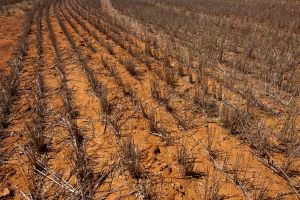Getting Group G use right for weed control in summer fallow
Getting Group G use right for weed control in summer fallow
Date: 02 Dec 2020

Group G mode of action herbicides have predominantly been used at a relatively low rate – as a spike – in combination with another non-selective herbicide as a knockdown in fallow or ahead of planting.
Group G chemistry inhibits part of the process for making chlorophyll, with plant leaves dying as a result. Herbicide uptake is usually through contact on the leaves of emerged weeds or taken up from the soil as the weed seedlings break through the soil surface.
The choice of partner herbicide for Group G products is commonly a decision between either glyphosate or a paraquat-based chemical.
Fast-acting Group G herbicides destroy cells on contact, so may not always be the ideal mixing partner for glyphosate, which is a systemic herbicide that takes time to enter and translocate throughout the weed.
While this Group G and a glyphosate mix is common and often effective, the biochemical properties of these different herbicides means that this mixture is a compromise and may potentially have adverse effects on weed control, especially grasses where a reduction in efficacy is more apparent.
For more information about getting the mix right, go to the GRDC Mixing knockdown partners with Group G herbicides fact sheet.
With the recent release of some new herbicide products, a range of new use patterns and active ingredients in the Group G class will provide improved pre-emptive control for early germinating weeds.
These new use patterns and active ingredients require additional considerations on-farm, such as weed spectrum and plant-backs, which need to be taken into account for optimum use. However, the new range also provides alternatives to other existing chemistries where varying levels of resistance exist.
There have been no recorded cases of weed resistance to Group G herbicides in Australia.
However, Grains Research and Development Corporation (GRDC) Weeds Manager Jason Emms said growers should remember these chemistries have been used in small quantities for more than 15 years and it was critical to preserve their efficacy now that use patterns were changing.
Dr Emms said to avoid resistance issues, growers need to take an integrated approach to weed management by following the WeedSmart Big Six tactics.

A range of resources are available to provide information on the best use of Group G herbicides.
For more information on the latest suite of Group G herbicides, read WeedSmart’s Group G herbicides and effectiveness for herbicide resistance article.
For information on how to make the right decision on using Group Gs in the northern cropping system, go to the recent WeedSmart webinar with Andrew Somervaille and Paul McIntosh.
For information on how to make the right decision on using Group Gs in southern farming systems, go to the WeedSmart webinar with Chris Preston and Chris Davey.
Growers can also watch a GRDC video focused on What you should know about the new pre-emergent herbicides with University of Adelaide’s Professor of Weed Management Chris Preston.
Additional information is available in a WeedSmart webinar with New South Wales agronomist Greg Condon: New chemistry – What’s new, what’s coming and how to keep them longer.
Contact Details
Toni Somes, GRDC
0436 622 645
